Comprehensive Business Environment Analysis: Marks & Spencer Report
VerifiedAdded on 2020/12/09
|14
|3505
|469
Report
AI Summary
This report provides a comprehensive analysis of the business environment of Marks & Spencer, a British multinational retailer. It begins by differentiating between public, private, and voluntary organizations, highlighting the purposes of each, and then focuses on Marks & Spencer. The report includes a stakeholder mapping exercise to identify key stakeholders. It then delves into macro and micro industry analyses, employing PESTLE, Porter's Five Forces, and SWOT analyses to assess the external and internal factors influencing the company's operations and performance. The PESTLE analysis examines political, economic, social, technological, legal, and environmental factors, while the industry analysis provides insights into competitive forces and strategic positioning. The report concludes with a synthesis of findings and implications for Marks & Spencer.
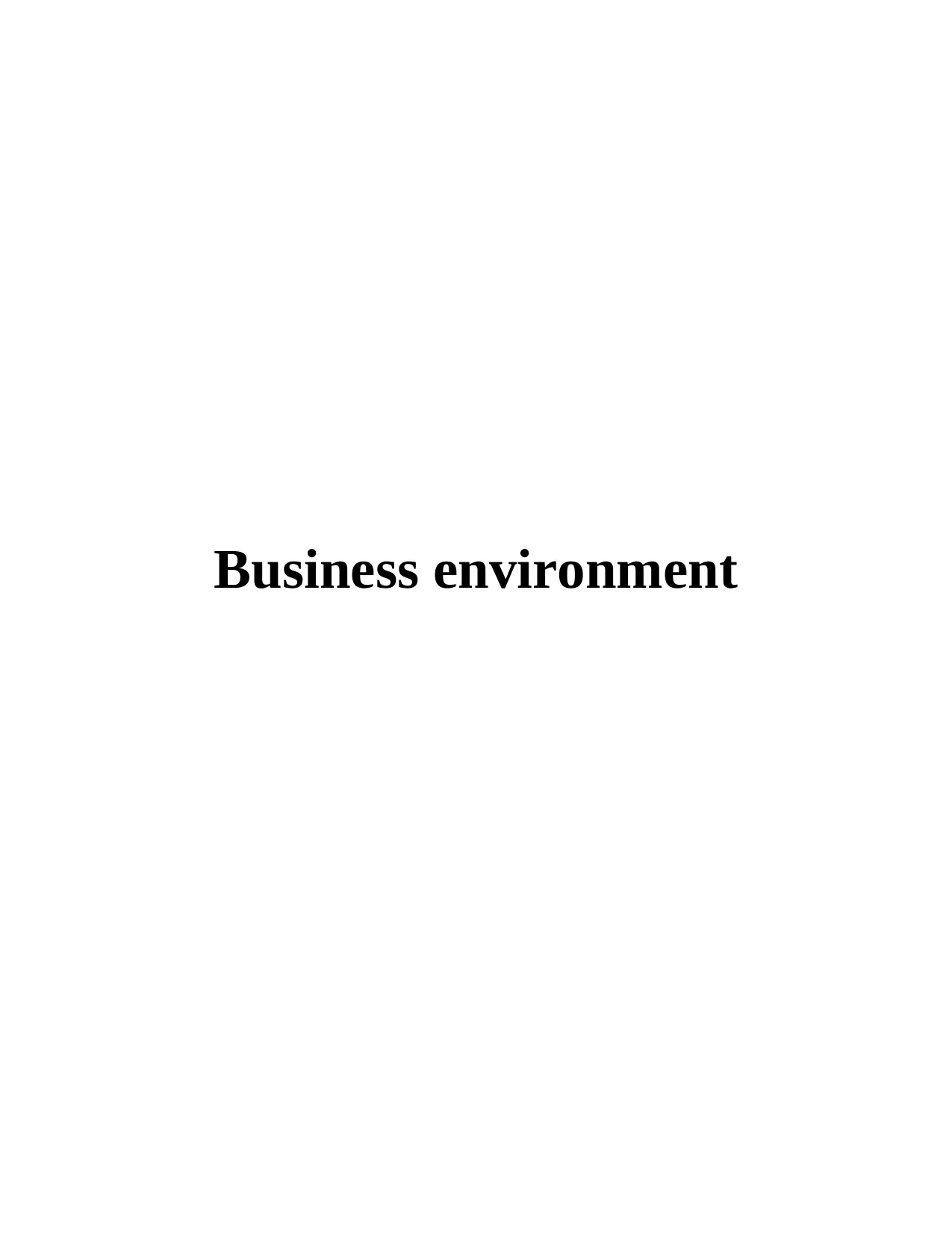
Business environment
Paraphrase This Document
Need a fresh take? Get an instant paraphrase of this document with our AI Paraphraser
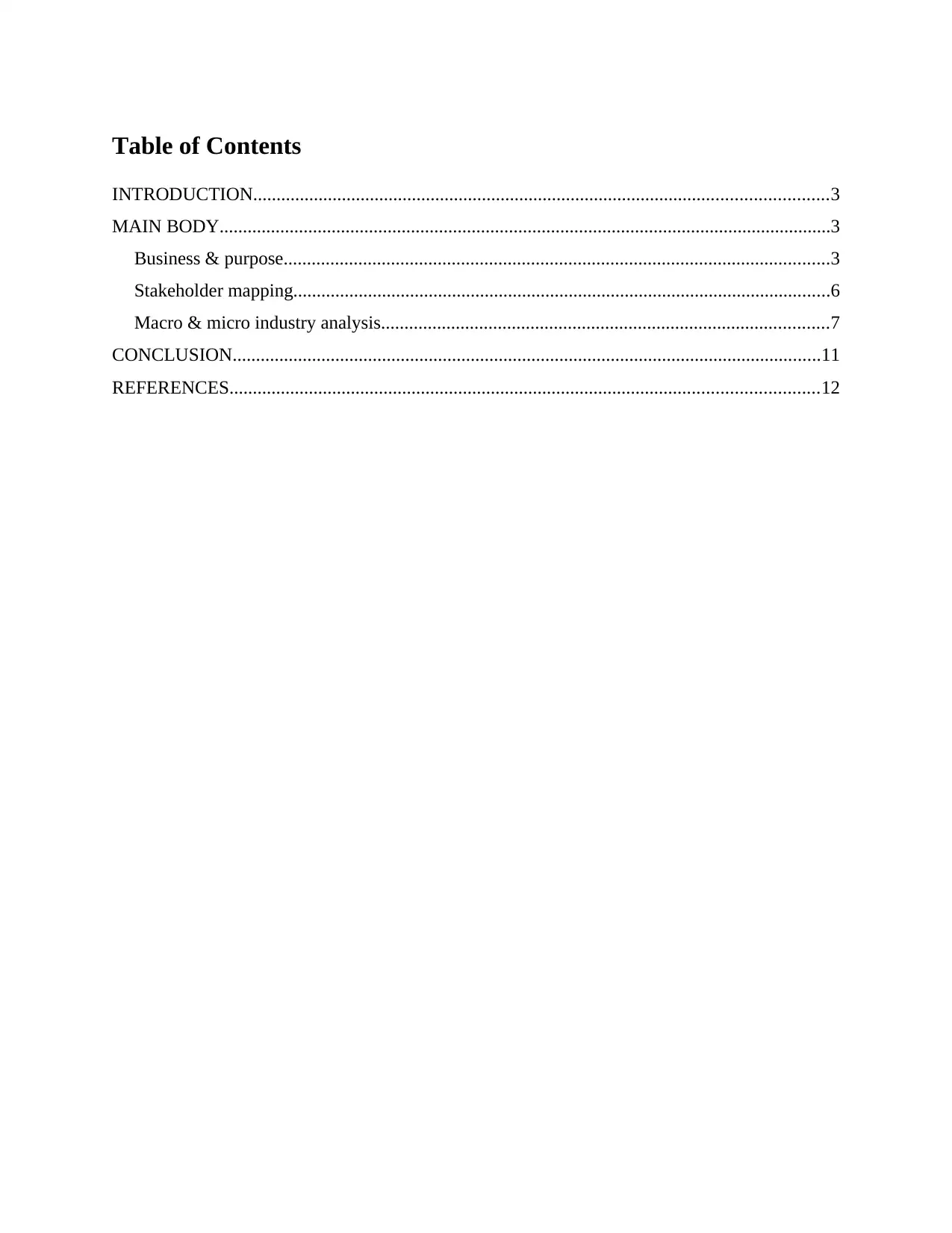
Table of Contents
INTRODUCTION...........................................................................................................................3
MAIN BODY...................................................................................................................................3
Business & purpose.....................................................................................................................3
Stakeholder mapping...................................................................................................................6
Macro & micro industry analysis................................................................................................7
CONCLUSION..............................................................................................................................11
REFERENCES..............................................................................................................................12
INTRODUCTION...........................................................................................................................3
MAIN BODY...................................................................................................................................3
Business & purpose.....................................................................................................................3
Stakeholder mapping...................................................................................................................6
Macro & micro industry analysis................................................................................................7
CONCLUSION..............................................................................................................................11
REFERENCES..............................................................................................................................12
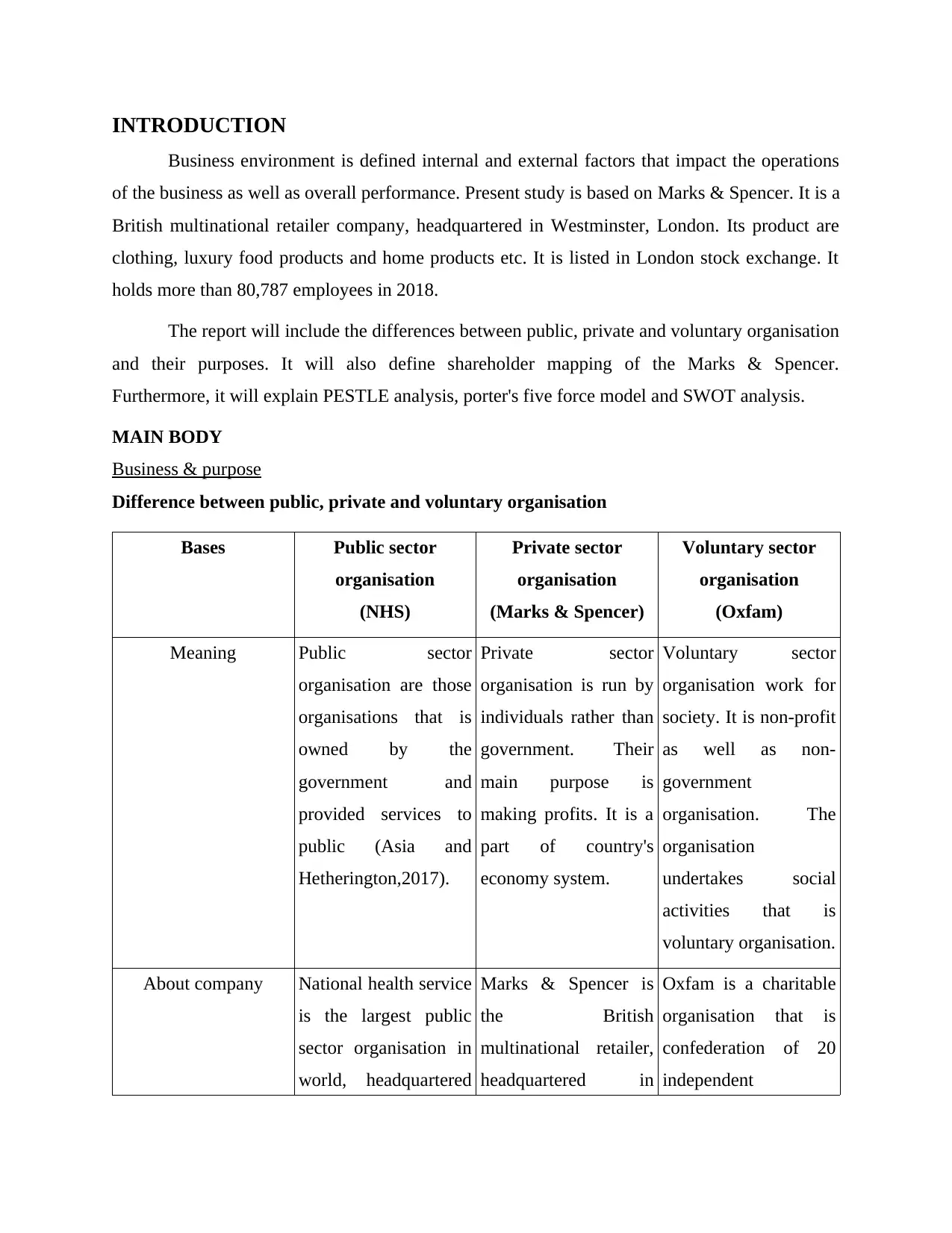
INTRODUCTION
Business environment is defined internal and external factors that impact the operations
of the business as well as overall performance. Present study is based on Marks & Spencer. It is a
British multinational retailer company, headquartered in Westminster, London. Its product are
clothing, luxury food products and home products etc. It is listed in London stock exchange. It
holds more than 80,787 employees in 2018.
The report will include the differences between public, private and voluntary organisation
and their purposes. It will also define shareholder mapping of the Marks & Spencer.
Furthermore, it will explain PESTLE analysis, porter's five force model and SWOT analysis.
MAIN BODY
Business & purpose
Difference between public, private and voluntary organisation
Bases Public sector
organisation
(NHS)
Private sector
organisation
(Marks & Spencer)
Voluntary sector
organisation
(Oxfam)
Meaning Public sector
organisation are those
organisations that is
owned by the
government and
provided services to
public (Asia and
Hetherington,2017).
Private sector
organisation is run by
individuals rather than
government. Their
main purpose is
making profits. It is a
part of country's
economy system.
Voluntary sector
organisation work for
society. It is non-profit
as well as non-
government
organisation. The
organisation
undertakes social
activities that is
voluntary organisation.
About company National health service
is the largest public
sector organisation in
world, headquartered
Marks & Spencer is
the British
multinational retailer,
headquartered in
Oxfam is a charitable
organisation that is
confederation of 20
independent
Business environment is defined internal and external factors that impact the operations
of the business as well as overall performance. Present study is based on Marks & Spencer. It is a
British multinational retailer company, headquartered in Westminster, London. Its product are
clothing, luxury food products and home products etc. It is listed in London stock exchange. It
holds more than 80,787 employees in 2018.
The report will include the differences between public, private and voluntary organisation
and their purposes. It will also define shareholder mapping of the Marks & Spencer.
Furthermore, it will explain PESTLE analysis, porter's five force model and SWOT analysis.
MAIN BODY
Business & purpose
Difference between public, private and voluntary organisation
Bases Public sector
organisation
(NHS)
Private sector
organisation
(Marks & Spencer)
Voluntary sector
organisation
(Oxfam)
Meaning Public sector
organisation are those
organisations that is
owned by the
government and
provided services to
public (Asia and
Hetherington,2017).
Private sector
organisation is run by
individuals rather than
government. Their
main purpose is
making profits. It is a
part of country's
economy system.
Voluntary sector
organisation work for
society. It is non-profit
as well as non-
government
organisation. The
organisation
undertakes social
activities that is
voluntary organisation.
About company National health service
is the largest public
sector organisation in
world, headquartered
Marks & Spencer is
the British
multinational retailer,
headquartered in
Oxfam is a charitable
organisation that is
confederation of 20
independent
⊘ This is a preview!⊘
Do you want full access?
Subscribe today to unlock all pages.

Trusted by 1+ million students worldwide
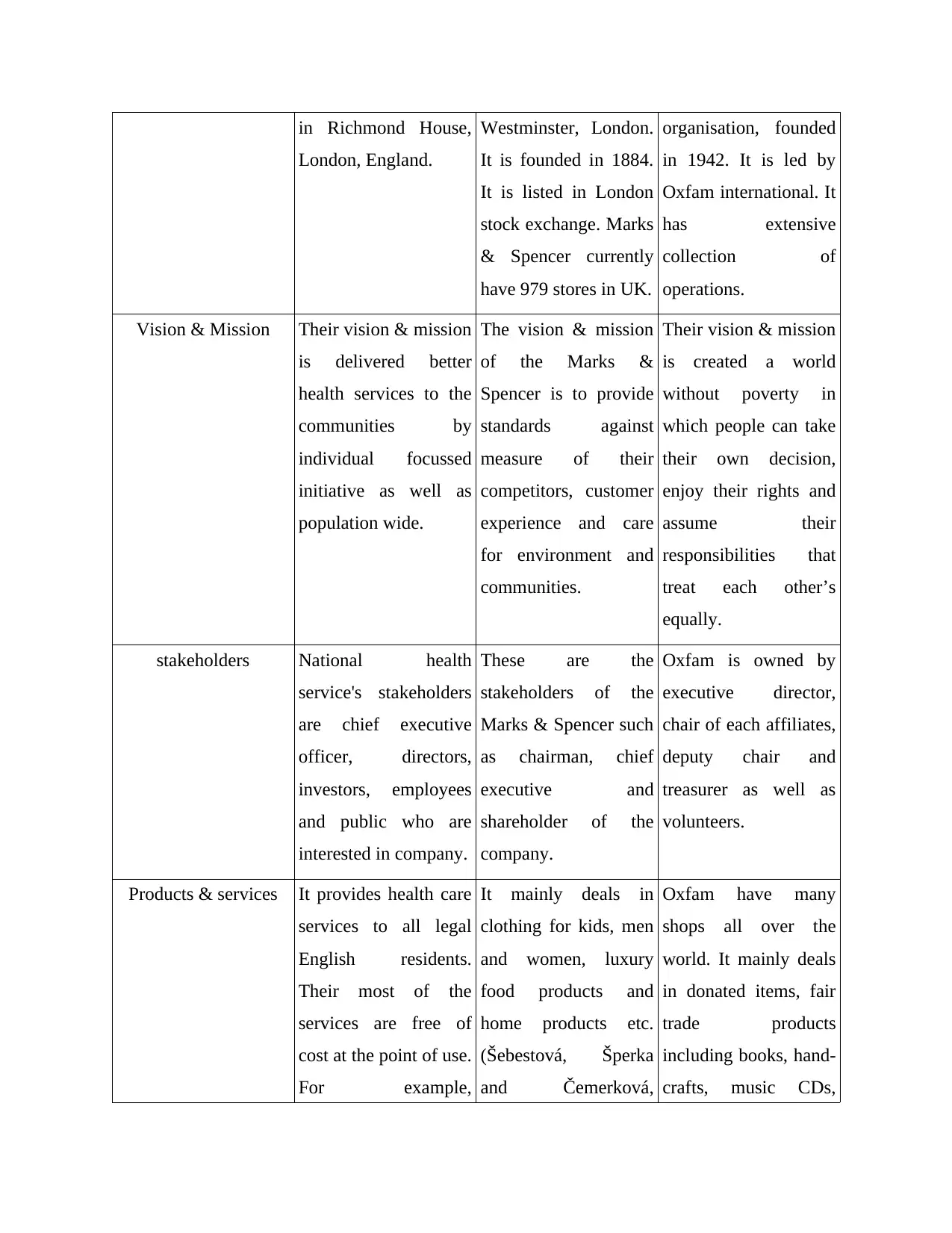
in Richmond House,
London, England.
Westminster, London.
It is founded in 1884.
It is listed in London
stock exchange. Marks
& Spencer currently
have 979 stores in UK.
organisation, founded
in 1942. It is led by
Oxfam international. It
has extensive
collection of
operations.
Vision & Mission Their vision & mission
is delivered better
health services to the
communities by
individual focussed
initiative as well as
population wide.
The vision & mission
of the Marks &
Spencer is to provide
standards against
measure of their
competitors, customer
experience and care
for environment and
communities.
Their vision & mission
is created a world
without poverty in
which people can take
their own decision,
enjoy their rights and
assume their
responsibilities that
treat each other’s
equally.
stakeholders National health
service's stakeholders
are chief executive
officer, directors,
investors, employees
and public who are
interested in company.
These are the
stakeholders of the
Marks & Spencer such
as chairman, chief
executive and
shareholder of the
company.
Oxfam is owned by
executive director,
chair of each affiliates,
deputy chair and
treasurer as well as
volunteers.
Products & services It provides health care
services to all legal
English residents.
Their most of the
services are free of
cost at the point of use.
For example,
It mainly deals in
clothing for kids, men
and women, luxury
food products and
home products etc.
(Šebestová, Šperka
and Čemerková,
Oxfam have many
shops all over the
world. It mainly deals
in donated items, fair
trade products
including books, hand-
crafts, music CDs,
London, England.
Westminster, London.
It is founded in 1884.
It is listed in London
stock exchange. Marks
& Spencer currently
have 979 stores in UK.
organisation, founded
in 1942. It is led by
Oxfam international. It
has extensive
collection of
operations.
Vision & Mission Their vision & mission
is delivered better
health services to the
communities by
individual focussed
initiative as well as
population wide.
The vision & mission
of the Marks &
Spencer is to provide
standards against
measure of their
competitors, customer
experience and care
for environment and
communities.
Their vision & mission
is created a world
without poverty in
which people can take
their own decision,
enjoy their rights and
assume their
responsibilities that
treat each other’s
equally.
stakeholders National health
service's stakeholders
are chief executive
officer, directors,
investors, employees
and public who are
interested in company.
These are the
stakeholders of the
Marks & Spencer such
as chairman, chief
executive and
shareholder of the
company.
Oxfam is owned by
executive director,
chair of each affiliates,
deputy chair and
treasurer as well as
volunteers.
Products & services It provides health care
services to all legal
English residents.
Their most of the
services are free of
cost at the point of use.
For example,
It mainly deals in
clothing for kids, men
and women, luxury
food products and
home products etc.
(Šebestová, Šperka
and Čemerková,
Oxfam have many
shops all over the
world. It mainly deals
in donated items, fair
trade products
including books, hand-
crafts, music CDs,
Paraphrase This Document
Need a fresh take? Get an instant paraphrase of this document with our AI Paraphraser
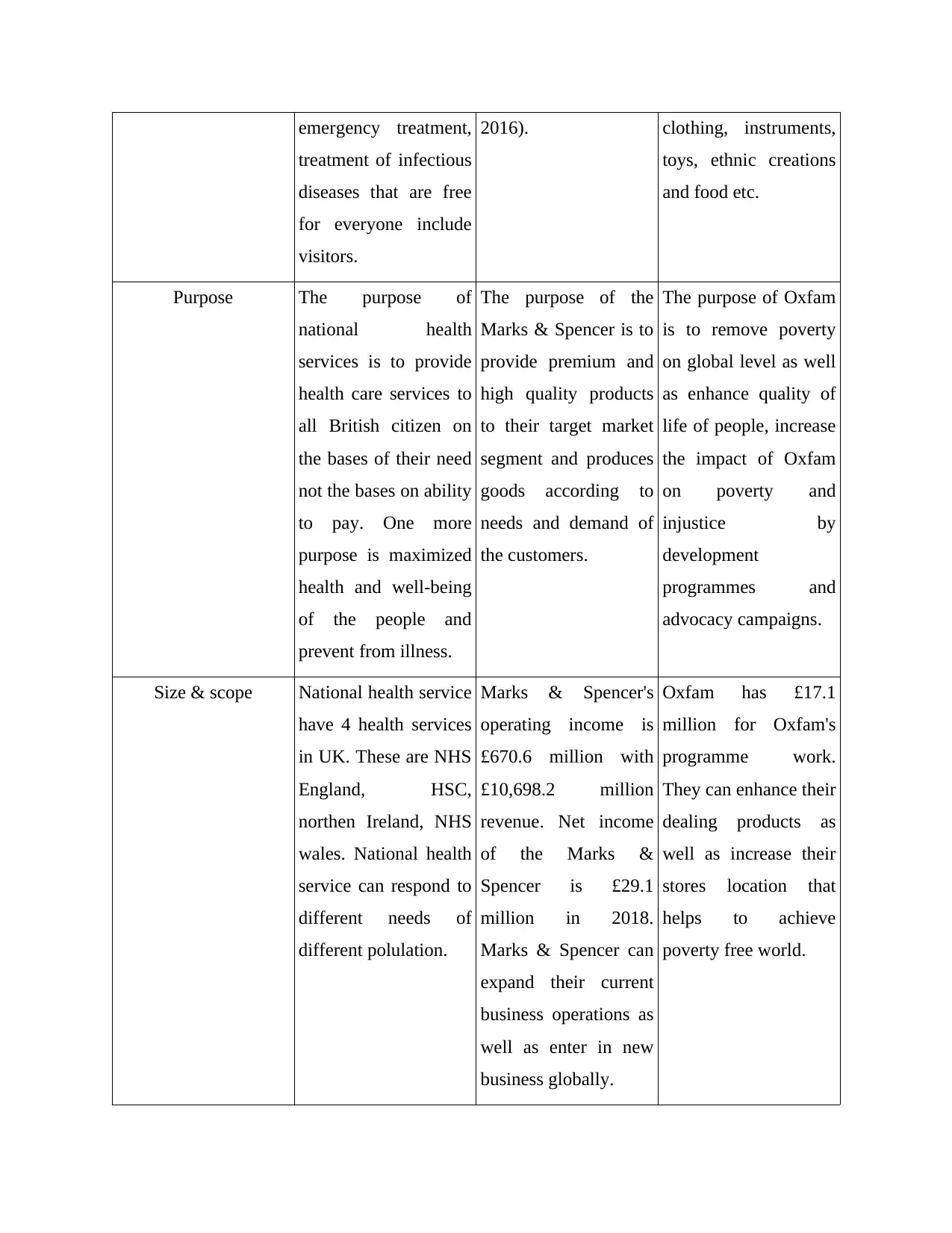
emergency treatment,
treatment of infectious
diseases that are free
for everyone include
visitors.
2016). clothing, instruments,
toys, ethnic creations
and food etc.
Purpose The purpose of
national health
services is to provide
health care services to
all British citizen on
the bases of their need
not the bases on ability
to pay. One more
purpose is maximized
health and well-being
of the people and
prevent from illness.
The purpose of the
Marks & Spencer is to
provide premium and
high quality products
to their target market
segment and produces
goods according to
needs and demand of
the customers.
The purpose of Oxfam
is to remove poverty
on global level as well
as enhance quality of
life of people, increase
the impact of Oxfam
on poverty and
injustice by
development
programmes and
advocacy campaigns.
Size & scope National health service
have 4 health services
in UK. These are NHS
England, HSC,
northen Ireland, NHS
wales. National health
service can respond to
different needs of
different polulation.
Marks & Spencer's
operating income is
£670.6 million with
£10,698.2 million
revenue. Net income
of the Marks &
Spencer is £29.1
million in 2018.
Marks & Spencer can
expand their current
business operations as
well as enter in new
business globally.
Oxfam has £17.1
million for Oxfam's
programme work.
They can enhance their
dealing products as
well as increase their
stores location that
helps to achieve
poverty free world.
treatment of infectious
diseases that are free
for everyone include
visitors.
2016). clothing, instruments,
toys, ethnic creations
and food etc.
Purpose The purpose of
national health
services is to provide
health care services to
all British citizen on
the bases of their need
not the bases on ability
to pay. One more
purpose is maximized
health and well-being
of the people and
prevent from illness.
The purpose of the
Marks & Spencer is to
provide premium and
high quality products
to their target market
segment and produces
goods according to
needs and demand of
the customers.
The purpose of Oxfam
is to remove poverty
on global level as well
as enhance quality of
life of people, increase
the impact of Oxfam
on poverty and
injustice by
development
programmes and
advocacy campaigns.
Size & scope National health service
have 4 health services
in UK. These are NHS
England, HSC,
northen Ireland, NHS
wales. National health
service can respond to
different needs of
different polulation.
Marks & Spencer's
operating income is
£670.6 million with
£10,698.2 million
revenue. Net income
of the Marks &
Spencer is £29.1
million in 2018.
Marks & Spencer can
expand their current
business operations as
well as enter in new
business globally.
Oxfam has £17.1
million for Oxfam's
programme work.
They can enhance their
dealing products as
well as increase their
stores location that
helps to achieve
poverty free world.
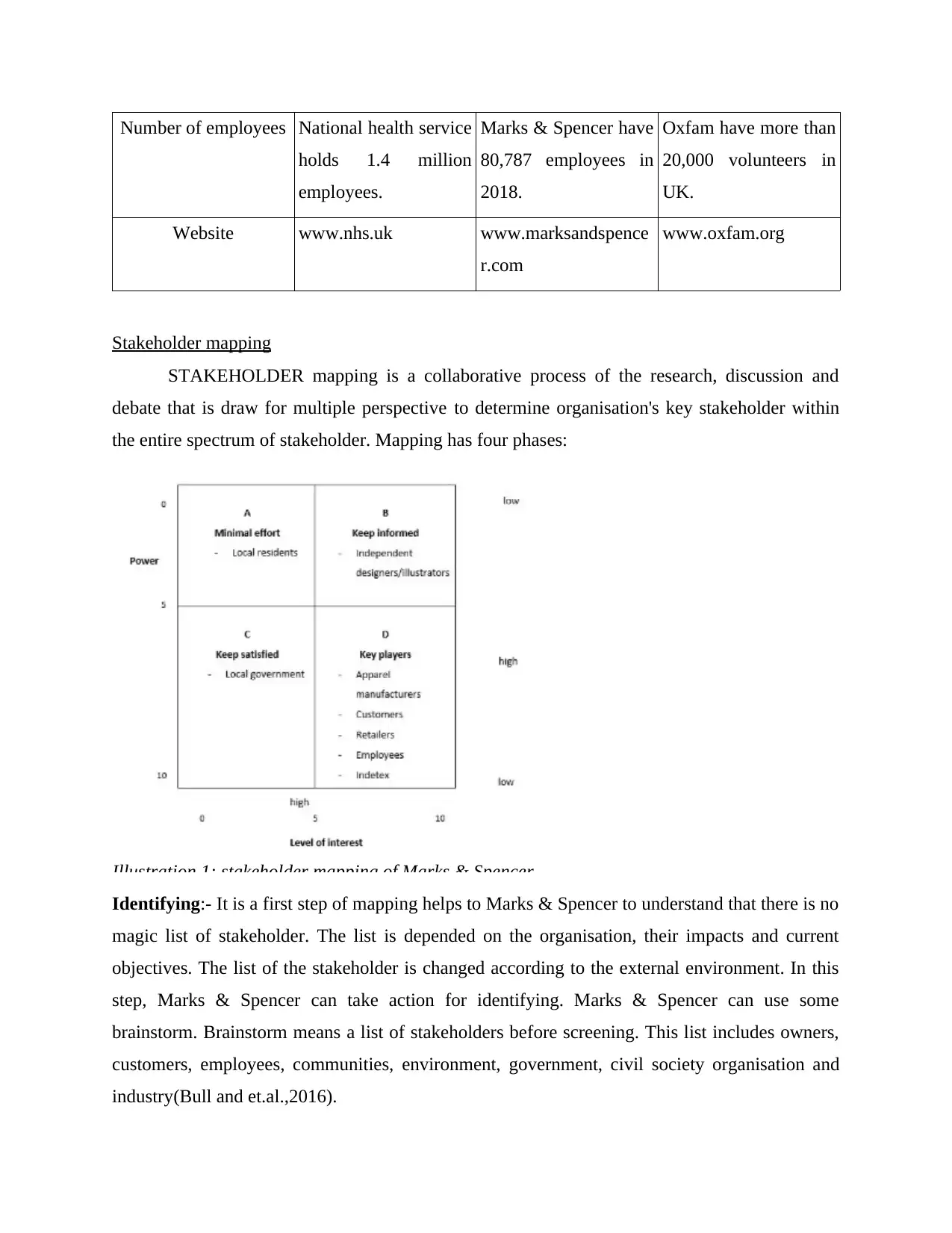
Number of employees National health service
holds 1.4 million
employees.
Marks & Spencer have
80,787 employees in
2018.
Oxfam have more than
20,000 volunteers in
UK.
Website www.nhs.uk www.marksandspence
r.com
www.oxfam.org
Stakeholder mapping
STAKEHOLDER mapping is a collaborative process of the research, discussion and
debate that is draw for multiple perspective to determine organisation's key stakeholder within
the entire spectrum of stakeholder. Mapping has four phases:
Illustration 1: stakeholder mapping of Marks & Spencer
Identifying:- It is a first step of mapping helps to Marks & Spencer to understand that there is no
magic list of stakeholder. The list is depended on the organisation, their impacts and current
objectives. The list of the stakeholder is changed according to the external environment. In this
step, Marks & Spencer can take action for identifying. Marks & Spencer can use some
brainstorm. Brainstorm means a list of stakeholders before screening. This list includes owners,
customers, employees, communities, environment, government, civil society organisation and
industry(Bull and et.al.,2016).
holds 1.4 million
employees.
Marks & Spencer have
80,787 employees in
2018.
Oxfam have more than
20,000 volunteers in
UK.
Website www.nhs.uk www.marksandspence
r.com
www.oxfam.org
Stakeholder mapping
STAKEHOLDER mapping is a collaborative process of the research, discussion and
debate that is draw for multiple perspective to determine organisation's key stakeholder within
the entire spectrum of stakeholder. Mapping has four phases:
Illustration 1: stakeholder mapping of Marks & Spencer
Identifying:- It is a first step of mapping helps to Marks & Spencer to understand that there is no
magic list of stakeholder. The list is depended on the organisation, their impacts and current
objectives. The list of the stakeholder is changed according to the external environment. In this
step, Marks & Spencer can take action for identifying. Marks & Spencer can use some
brainstorm. Brainstorm means a list of stakeholders before screening. This list includes owners,
customers, employees, communities, environment, government, civil society organisation and
industry(Bull and et.al.,2016).
⊘ This is a preview!⊘
Do you want full access?
Subscribe today to unlock all pages.

Trusted by 1+ million students worldwide
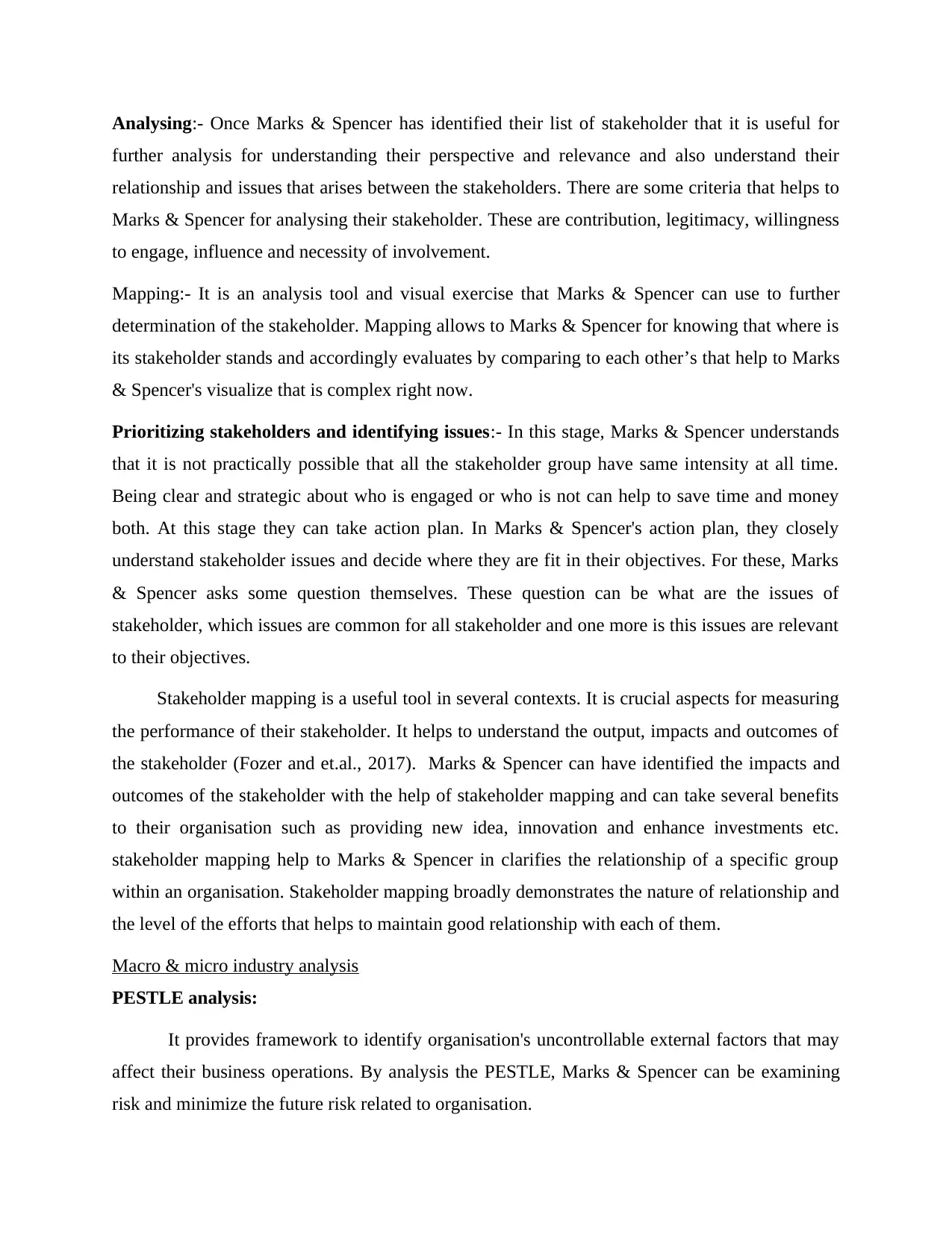
Analysing:- Once Marks & Spencer has identified their list of stakeholder that it is useful for
further analysis for understanding their perspective and relevance and also understand their
relationship and issues that arises between the stakeholders. There are some criteria that helps to
Marks & Spencer for analysing their stakeholder. These are contribution, legitimacy, willingness
to engage, influence and necessity of involvement.
Mapping:- It is an analysis tool and visual exercise that Marks & Spencer can use to further
determination of the stakeholder. Mapping allows to Marks & Spencer for knowing that where is
its stakeholder stands and accordingly evaluates by comparing to each other’s that help to Marks
& Spencer's visualize that is complex right now.
Prioritizing stakeholders and identifying issues:- In this stage, Marks & Spencer understands
that it is not practically possible that all the stakeholder group have same intensity at all time.
Being clear and strategic about who is engaged or who is not can help to save time and money
both. At this stage they can take action plan. In Marks & Spencer's action plan, they closely
understand stakeholder issues and decide where they are fit in their objectives. For these, Marks
& Spencer asks some question themselves. These question can be what are the issues of
stakeholder, which issues are common for all stakeholder and one more is this issues are relevant
to their objectives.
Stakeholder mapping is a useful tool in several contexts. It is crucial aspects for measuring
the performance of their stakeholder. It helps to understand the output, impacts and outcomes of
the stakeholder (Fozer and et.al., 2017). Marks & Spencer can have identified the impacts and
outcomes of the stakeholder with the help of stakeholder mapping and can take several benefits
to their organisation such as providing new idea, innovation and enhance investments etc.
stakeholder mapping help to Marks & Spencer in clarifies the relationship of a specific group
within an organisation. Stakeholder mapping broadly demonstrates the nature of relationship and
the level of the efforts that helps to maintain good relationship with each of them.
Macro & micro industry analysis
PESTLE analysis:
It provides framework to identify organisation's uncontrollable external factors that may
affect their business operations. By analysis the PESTLE, Marks & Spencer can be examining
risk and minimize the future risk related to organisation.
further analysis for understanding their perspective and relevance and also understand their
relationship and issues that arises between the stakeholders. There are some criteria that helps to
Marks & Spencer for analysing their stakeholder. These are contribution, legitimacy, willingness
to engage, influence and necessity of involvement.
Mapping:- It is an analysis tool and visual exercise that Marks & Spencer can use to further
determination of the stakeholder. Mapping allows to Marks & Spencer for knowing that where is
its stakeholder stands and accordingly evaluates by comparing to each other’s that help to Marks
& Spencer's visualize that is complex right now.
Prioritizing stakeholders and identifying issues:- In this stage, Marks & Spencer understands
that it is not practically possible that all the stakeholder group have same intensity at all time.
Being clear and strategic about who is engaged or who is not can help to save time and money
both. At this stage they can take action plan. In Marks & Spencer's action plan, they closely
understand stakeholder issues and decide where they are fit in their objectives. For these, Marks
& Spencer asks some question themselves. These question can be what are the issues of
stakeholder, which issues are common for all stakeholder and one more is this issues are relevant
to their objectives.
Stakeholder mapping is a useful tool in several contexts. It is crucial aspects for measuring
the performance of their stakeholder. It helps to understand the output, impacts and outcomes of
the stakeholder (Fozer and et.al., 2017). Marks & Spencer can have identified the impacts and
outcomes of the stakeholder with the help of stakeholder mapping and can take several benefits
to their organisation such as providing new idea, innovation and enhance investments etc.
stakeholder mapping help to Marks & Spencer in clarifies the relationship of a specific group
within an organisation. Stakeholder mapping broadly demonstrates the nature of relationship and
the level of the efforts that helps to maintain good relationship with each of them.
Macro & micro industry analysis
PESTLE analysis:
It provides framework to identify organisation's uncontrollable external factors that may
affect their business operations. By analysis the PESTLE, Marks & Spencer can be examining
risk and minimize the future risk related to organisation.
Paraphrase This Document
Need a fresh take? Get an instant paraphrase of this document with our AI Paraphraser
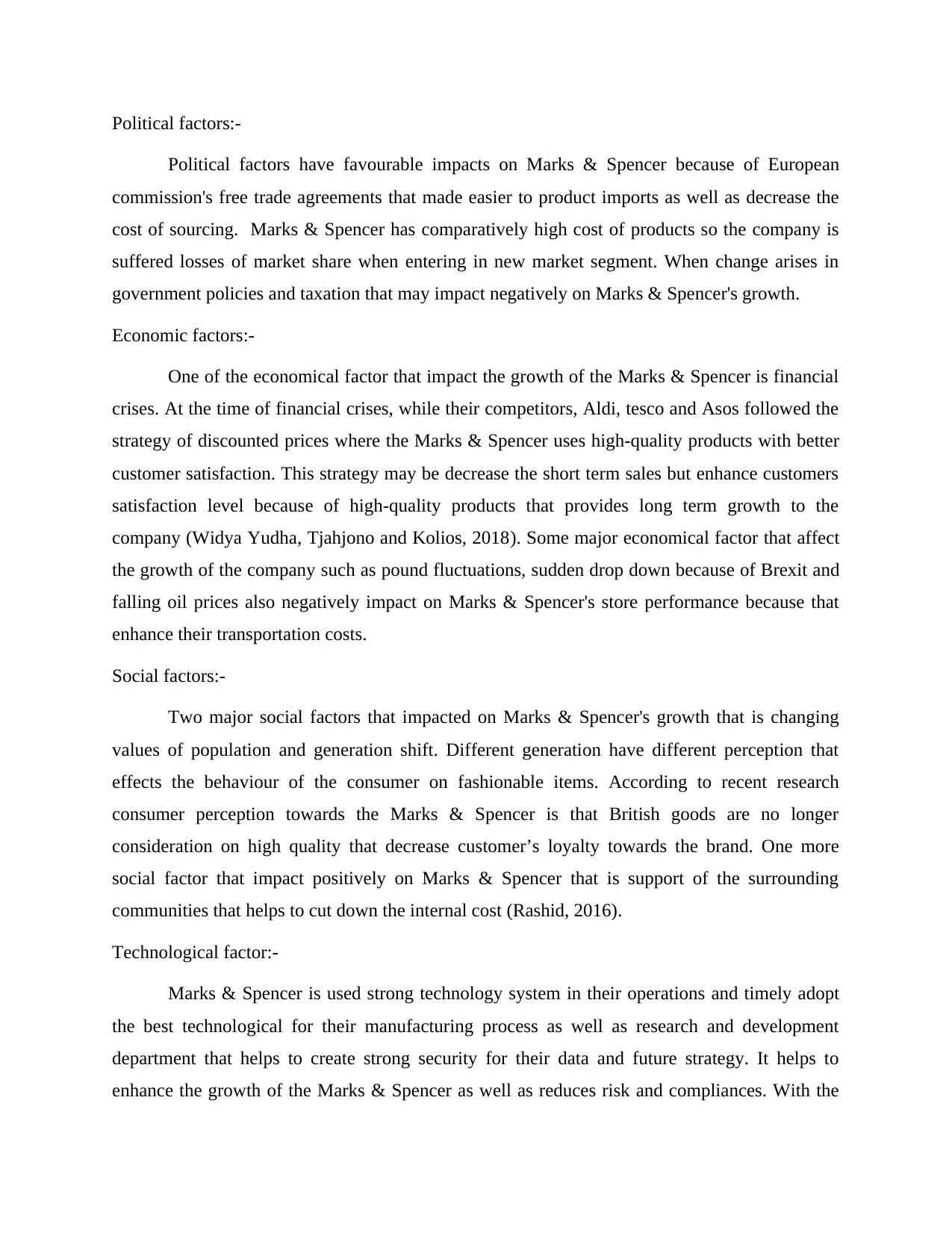
Political factors:-
Political factors have favourable impacts on Marks & Spencer because of European
commission's free trade agreements that made easier to product imports as well as decrease the
cost of sourcing. Marks & Spencer has comparatively high cost of products so the company is
suffered losses of market share when entering in new market segment. When change arises in
government policies and taxation that may impact negatively on Marks & Spencer's growth.
Economic factors:-
One of the economical factor that impact the growth of the Marks & Spencer is financial
crises. At the time of financial crises, while their competitors, Aldi, tesco and Asos followed the
strategy of discounted prices where the Marks & Spencer uses high-quality products with better
customer satisfaction. This strategy may be decrease the short term sales but enhance customers
satisfaction level because of high-quality products that provides long term growth to the
company (Widya Yudha, Tjahjono and Kolios, 2018). Some major economical factor that affect
the growth of the company such as pound fluctuations, sudden drop down because of Brexit and
falling oil prices also negatively impact on Marks & Spencer's store performance because that
enhance their transportation costs.
Social factors:-
Two major social factors that impacted on Marks & Spencer's growth that is changing
values of population and generation shift. Different generation have different perception that
effects the behaviour of the consumer on fashionable items. According to recent research
consumer perception towards the Marks & Spencer is that British goods are no longer
consideration on high quality that decrease customer’s loyalty towards the brand. One more
social factor that impact positively on Marks & Spencer that is support of the surrounding
communities that helps to cut down the internal cost (Rashid, 2016).
Technological factor:-
Marks & Spencer is used strong technology system in their operations and timely adopt
the best technological for their manufacturing process as well as research and development
department that helps to create strong security for their data and future strategy. It helps to
enhance the growth of the Marks & Spencer as well as reduces risk and compliances. With the
Political factors have favourable impacts on Marks & Spencer because of European
commission's free trade agreements that made easier to product imports as well as decrease the
cost of sourcing. Marks & Spencer has comparatively high cost of products so the company is
suffered losses of market share when entering in new market segment. When change arises in
government policies and taxation that may impact negatively on Marks & Spencer's growth.
Economic factors:-
One of the economical factor that impact the growth of the Marks & Spencer is financial
crises. At the time of financial crises, while their competitors, Aldi, tesco and Asos followed the
strategy of discounted prices where the Marks & Spencer uses high-quality products with better
customer satisfaction. This strategy may be decrease the short term sales but enhance customers
satisfaction level because of high-quality products that provides long term growth to the
company (Widya Yudha, Tjahjono and Kolios, 2018). Some major economical factor that affect
the growth of the company such as pound fluctuations, sudden drop down because of Brexit and
falling oil prices also negatively impact on Marks & Spencer's store performance because that
enhance their transportation costs.
Social factors:-
Two major social factors that impacted on Marks & Spencer's growth that is changing
values of population and generation shift. Different generation have different perception that
effects the behaviour of the consumer on fashionable items. According to recent research
consumer perception towards the Marks & Spencer is that British goods are no longer
consideration on high quality that decrease customer’s loyalty towards the brand. One more
social factor that impact positively on Marks & Spencer that is support of the surrounding
communities that helps to cut down the internal cost (Rashid, 2016).
Technological factor:-
Marks & Spencer is used strong technology system in their operations and timely adopt
the best technological for their manufacturing process as well as research and development
department that helps to create strong security for their data and future strategy. It helps to
enhance the growth of the Marks & Spencer as well as reduces risk and compliances. With the
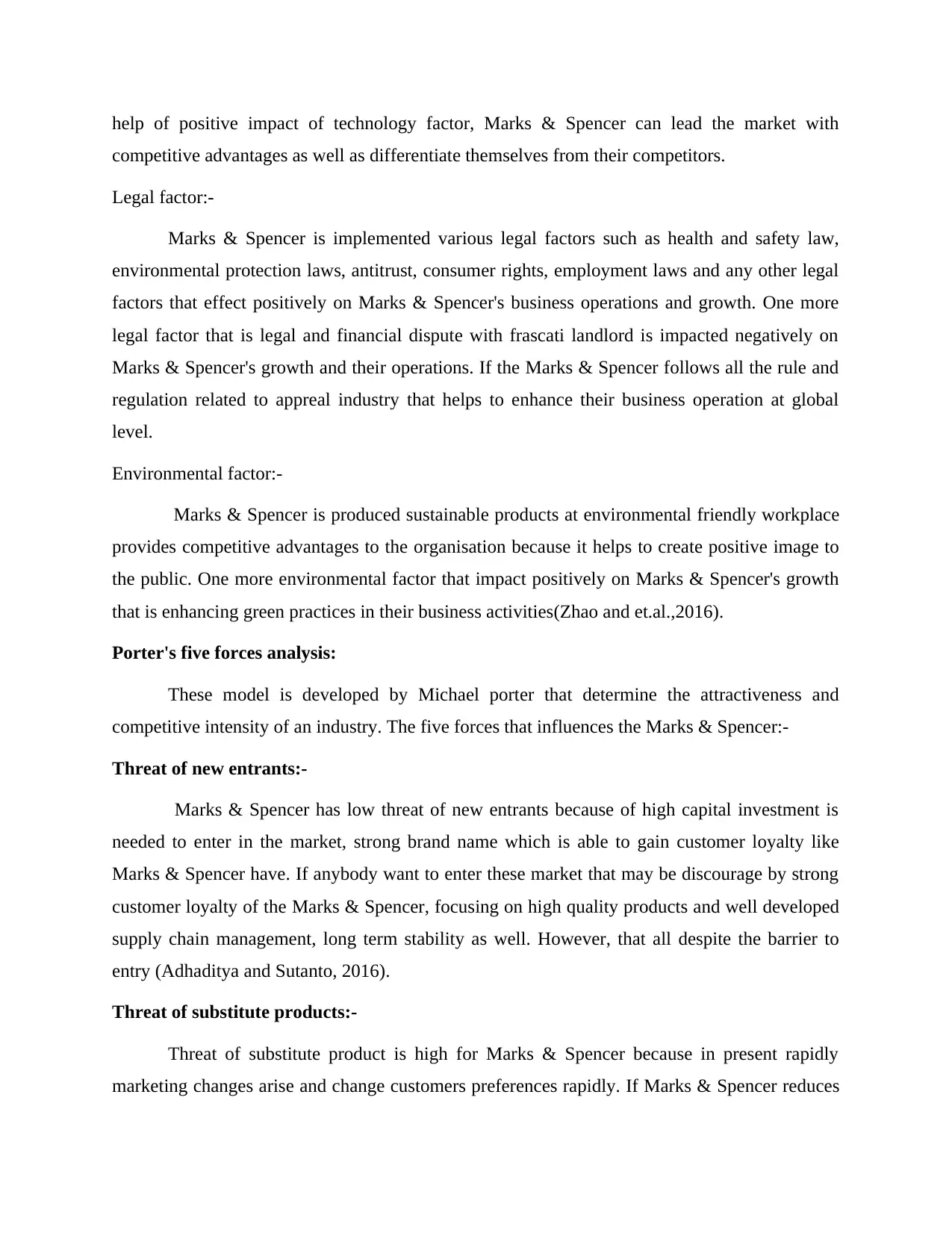
help of positive impact of technology factor, Marks & Spencer can lead the market with
competitive advantages as well as differentiate themselves from their competitors.
Legal factor:-
Marks & Spencer is implemented various legal factors such as health and safety law,
environmental protection laws, antitrust, consumer rights, employment laws and any other legal
factors that effect positively on Marks & Spencer's business operations and growth. One more
legal factor that is legal and financial dispute with frascati landlord is impacted negatively on
Marks & Spencer's growth and their operations. If the Marks & Spencer follows all the rule and
regulation related to appreal industry that helps to enhance their business operation at global
level.
Environmental factor:-
Marks & Spencer is produced sustainable products at environmental friendly workplace
provides competitive advantages to the organisation because it helps to create positive image to
the public. One more environmental factor that impact positively on Marks & Spencer's growth
that is enhancing green practices in their business activities(Zhao and et.al.,2016).
Porter's five forces analysis:
These model is developed by Michael porter that determine the attractiveness and
competitive intensity of an industry. The five forces that influences the Marks & Spencer:-
Threat of new entrants:-
Marks & Spencer has low threat of new entrants because of high capital investment is
needed to enter in the market, strong brand name which is able to gain customer loyalty like
Marks & Spencer have. If anybody want to enter these market that may be discourage by strong
customer loyalty of the Marks & Spencer, focusing on high quality products and well developed
supply chain management, long term stability as well. However, that all despite the barrier to
entry (Adhaditya and Sutanto, 2016).
Threat of substitute products:-
Threat of substitute product is high for Marks & Spencer because in present rapidly
marketing changes arise and change customers preferences rapidly. If Marks & Spencer reduces
competitive advantages as well as differentiate themselves from their competitors.
Legal factor:-
Marks & Spencer is implemented various legal factors such as health and safety law,
environmental protection laws, antitrust, consumer rights, employment laws and any other legal
factors that effect positively on Marks & Spencer's business operations and growth. One more
legal factor that is legal and financial dispute with frascati landlord is impacted negatively on
Marks & Spencer's growth and their operations. If the Marks & Spencer follows all the rule and
regulation related to appreal industry that helps to enhance their business operation at global
level.
Environmental factor:-
Marks & Spencer is produced sustainable products at environmental friendly workplace
provides competitive advantages to the organisation because it helps to create positive image to
the public. One more environmental factor that impact positively on Marks & Spencer's growth
that is enhancing green practices in their business activities(Zhao and et.al.,2016).
Porter's five forces analysis:
These model is developed by Michael porter that determine the attractiveness and
competitive intensity of an industry. The five forces that influences the Marks & Spencer:-
Threat of new entrants:-
Marks & Spencer has low threat of new entrants because of high capital investment is
needed to enter in the market, strong brand name which is able to gain customer loyalty like
Marks & Spencer have. If anybody want to enter these market that may be discourage by strong
customer loyalty of the Marks & Spencer, focusing on high quality products and well developed
supply chain management, long term stability as well. However, that all despite the barrier to
entry (Adhaditya and Sutanto, 2016).
Threat of substitute products:-
Threat of substitute product is high for Marks & Spencer because in present rapidly
marketing changes arise and change customers preferences rapidly. If Marks & Spencer reduces
⊘ This is a preview!⊘
Do you want full access?
Subscribe today to unlock all pages.

Trusted by 1+ million students worldwide
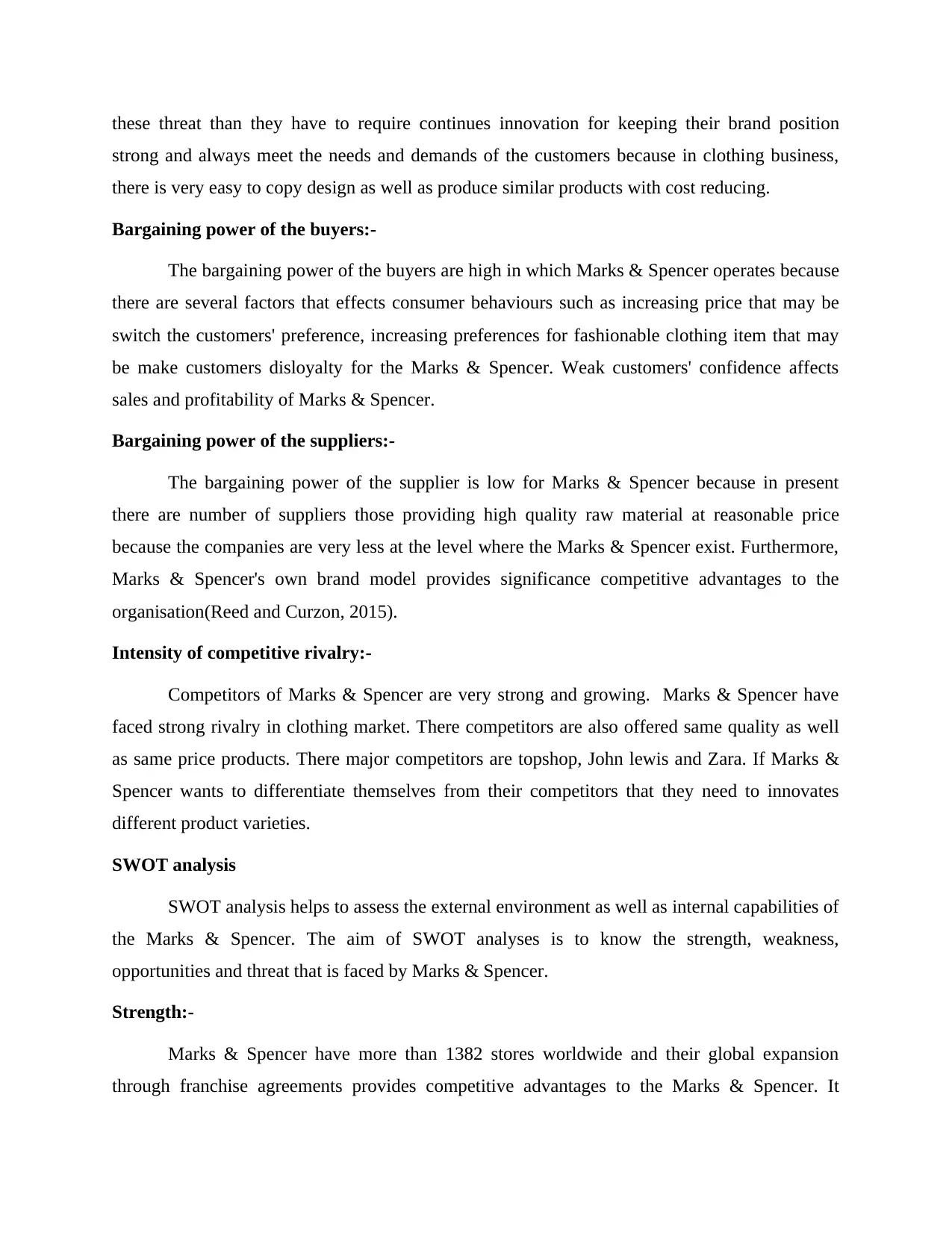
these threat than they have to require continues innovation for keeping their brand position
strong and always meet the needs and demands of the customers because in clothing business,
there is very easy to copy design as well as produce similar products with cost reducing.
Bargaining power of the buyers:-
The bargaining power of the buyers are high in which Marks & Spencer operates because
there are several factors that effects consumer behaviours such as increasing price that may be
switch the customers' preference, increasing preferences for fashionable clothing item that may
be make customers disloyalty for the Marks & Spencer. Weak customers' confidence affects
sales and profitability of Marks & Spencer.
Bargaining power of the suppliers:-
The bargaining power of the supplier is low for Marks & Spencer because in present
there are number of suppliers those providing high quality raw material at reasonable price
because the companies are very less at the level where the Marks & Spencer exist. Furthermore,
Marks & Spencer's own brand model provides significance competitive advantages to the
organisation(Reed and Curzon, 2015).
Intensity of competitive rivalry:-
Competitors of Marks & Spencer are very strong and growing. Marks & Spencer have
faced strong rivalry in clothing market. There competitors are also offered same quality as well
as same price products. There major competitors are topshop, John lewis and Zara. If Marks &
Spencer wants to differentiate themselves from their competitors that they need to innovates
different product varieties.
SWOT analysis
SWOT analysis helps to assess the external environment as well as internal capabilities of
the Marks & Spencer. The aim of SWOT analyses is to know the strength, weakness,
opportunities and threat that is faced by Marks & Spencer.
Strength:-
Marks & Spencer have more than 1382 stores worldwide and their global expansion
through franchise agreements provides competitive advantages to the Marks & Spencer. It
strong and always meet the needs and demands of the customers because in clothing business,
there is very easy to copy design as well as produce similar products with cost reducing.
Bargaining power of the buyers:-
The bargaining power of the buyers are high in which Marks & Spencer operates because
there are several factors that effects consumer behaviours such as increasing price that may be
switch the customers' preference, increasing preferences for fashionable clothing item that may
be make customers disloyalty for the Marks & Spencer. Weak customers' confidence affects
sales and profitability of Marks & Spencer.
Bargaining power of the suppliers:-
The bargaining power of the supplier is low for Marks & Spencer because in present
there are number of suppliers those providing high quality raw material at reasonable price
because the companies are very less at the level where the Marks & Spencer exist. Furthermore,
Marks & Spencer's own brand model provides significance competitive advantages to the
organisation(Reed and Curzon, 2015).
Intensity of competitive rivalry:-
Competitors of Marks & Spencer are very strong and growing. Marks & Spencer have
faced strong rivalry in clothing market. There competitors are also offered same quality as well
as same price products. There major competitors are topshop, John lewis and Zara. If Marks &
Spencer wants to differentiate themselves from their competitors that they need to innovates
different product varieties.
SWOT analysis
SWOT analysis helps to assess the external environment as well as internal capabilities of
the Marks & Spencer. The aim of SWOT analyses is to know the strength, weakness,
opportunities and threat that is faced by Marks & Spencer.
Strength:-
Marks & Spencer have more than 1382 stores worldwide and their global expansion
through franchise agreements provides competitive advantages to the Marks & Spencer. It
Paraphrase This Document
Need a fresh take? Get an instant paraphrase of this document with our AI Paraphraser
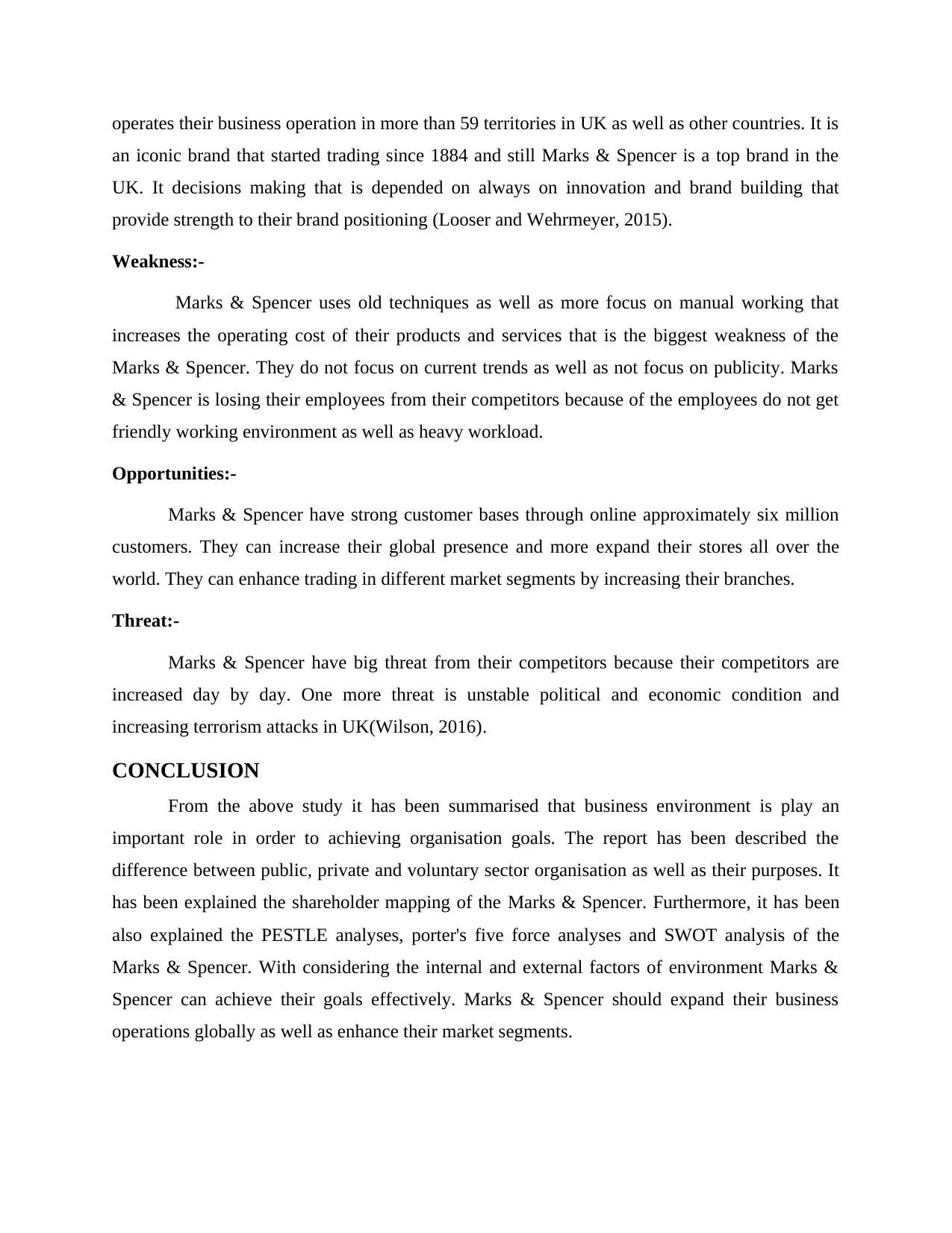
operates their business operation in more than 59 territories in UK as well as other countries. It is
an iconic brand that started trading since 1884 and still Marks & Spencer is a top brand in the
UK. It decisions making that is depended on always on innovation and brand building that
provide strength to their brand positioning (Looser and Wehrmeyer, 2015).
Weakness:-
Marks & Spencer uses old techniques as well as more focus on manual working that
increases the operating cost of their products and services that is the biggest weakness of the
Marks & Spencer. They do not focus on current trends as well as not focus on publicity. Marks
& Spencer is losing their employees from their competitors because of the employees do not get
friendly working environment as well as heavy workload.
Opportunities:-
Marks & Spencer have strong customer bases through online approximately six million
customers. They can increase their global presence and more expand their stores all over the
world. They can enhance trading in different market segments by increasing their branches.
Threat:-
Marks & Spencer have big threat from their competitors because their competitors are
increased day by day. One more threat is unstable political and economic condition and
increasing terrorism attacks in UK(Wilson, 2016).
CONCLUSION
From the above study it has been summarised that business environment is play an
important role in order to achieving organisation goals. The report has been described the
difference between public, private and voluntary sector organisation as well as their purposes. It
has been explained the shareholder mapping of the Marks & Spencer. Furthermore, it has been
also explained the PESTLE analyses, porter's five force analyses and SWOT analysis of the
Marks & Spencer. With considering the internal and external factors of environment Marks &
Spencer can achieve their goals effectively. Marks & Spencer should expand their business
operations globally as well as enhance their market segments.
an iconic brand that started trading since 1884 and still Marks & Spencer is a top brand in the
UK. It decisions making that is depended on always on innovation and brand building that
provide strength to their brand positioning (Looser and Wehrmeyer, 2015).
Weakness:-
Marks & Spencer uses old techniques as well as more focus on manual working that
increases the operating cost of their products and services that is the biggest weakness of the
Marks & Spencer. They do not focus on current trends as well as not focus on publicity. Marks
& Spencer is losing their employees from their competitors because of the employees do not get
friendly working environment as well as heavy workload.
Opportunities:-
Marks & Spencer have strong customer bases through online approximately six million
customers. They can increase their global presence and more expand their stores all over the
world. They can enhance trading in different market segments by increasing their branches.
Threat:-
Marks & Spencer have big threat from their competitors because their competitors are
increased day by day. One more threat is unstable political and economic condition and
increasing terrorism attacks in UK(Wilson, 2016).
CONCLUSION
From the above study it has been summarised that business environment is play an
important role in order to achieving organisation goals. The report has been described the
difference between public, private and voluntary sector organisation as well as their purposes. It
has been explained the shareholder mapping of the Marks & Spencer. Furthermore, it has been
also explained the PESTLE analyses, porter's five force analyses and SWOT analysis of the
Marks & Spencer. With considering the internal and external factors of environment Marks &
Spencer can achieve their goals effectively. Marks & Spencer should expand their business
operations globally as well as enhance their market segments.

⊘ This is a preview!⊘
Do you want full access?
Subscribe today to unlock all pages.

Trusted by 1+ million students worldwide
1 out of 14
Related Documents
Your All-in-One AI-Powered Toolkit for Academic Success.
+13062052269
info@desklib.com
Available 24*7 on WhatsApp / Email
![[object Object]](/_next/static/media/star-bottom.7253800d.svg)
Unlock your academic potential
Copyright © 2020–2025 A2Z Services. All Rights Reserved. Developed and managed by ZUCOL.




